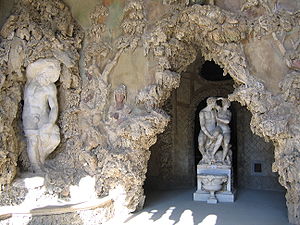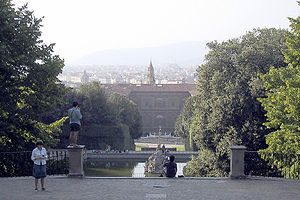Boboli Gardens
The Boboli Garden (Giardino di Boboli) is a park in Florence and home to an important collection of sculptures.
Located behind Palazzo Pitti, the Medici's headquarters as Grand Dukes of Tuscany, it is one of the most famous Italian gardens of the 16th century. In the horticultural style of the period, it features long axes, wide gravel paths, considerable "furnishing" by stone elements, the lavish use of statues and fountains, and a division into semi-private and public areas formed by classical accents: Grottoes, Nymphs, Garden Temples and the like. The openness of the garden, allowing extensive views over the city, was unusual for the time.
The Boboli Garden was laid out by Eleonora of Toledo, wife of Grand Duke Cosimo I. The land for the garden was bought from a Bogoli family, from which its name is derived. The first phase had just been begun by Niccolo Tribolo when he died in 1550, and was continued by Bartolomeo Ammanati, who was assisted in the planning by Giorgio Vasari, by whom some of the grottoes were also built, while the sculptures were by Bernardo Buontalenti. The architecture of the grotto in the courtyard that separates the palace from the garden is also by Buontalenti.
The main axis, facing the rear façade of the palazzo, rises from a low-lying amphitheatre - reminiscent in shape of half a classical hippodrome - up the Boboli Hill. In the middle of the amphitheatre is an Egyptian obelisk, brought here from the Villa Medici in Rome. This main axis ends at the Fountain of Neptune (which the irreverent Florentines call the Fountain of Forks) and a sculpture by Stoldo Lorenzi. A long second axis at right angles to the main axis leads through a series of terraces and water features.
The garden was expanded and rebuilt in several phases. In the 17th century it reached its present size of 4.5 hectares. It is now an open-air museum of garden sculpture, including Roman antiquities as well as works from the 16th and 17th centuries.
In the first phase of the works, the amphitheatre was excavated on the slope behind the palace. Initially consisting of dug terraces, it was only later extended in stone and provided with statues based on ancient mythology, such as the Fountain of Okeanos, sculpted by Giambologna, and only later given its present place in another part of the garden. The Small Madama Grotto and the Great Grotto were begun by Vasari and completed by Ammanati and Buontalenti between 1583 and 1593.
The great grotto is a remarkable example of Mannerism. Decorated inside and out with stalactites, and originally featuring water features and lush vegetation, the grotto is divided into three main parts. The first was intended to give the impression of a natural grotto with frescoes, where shepherds could shelter from wild animals, and originally contained Michelangelo's "The Prisoners" (now replaced by copies, the originals are in the Galleria dell'Accademia), which were originally intended for the tomb of Pope Julius II. Other rooms in the grotto contain Giambologna's famous Bathing Venus and a 16th-century Paris and Helena group by Vincenzo de Rossi.
The plant can be visited, the entrance is liable to pay costs.

The interior of the Buontalentis cave

View from the Boboli Garden to Palazzo Pitti
Search within the encyclopedia